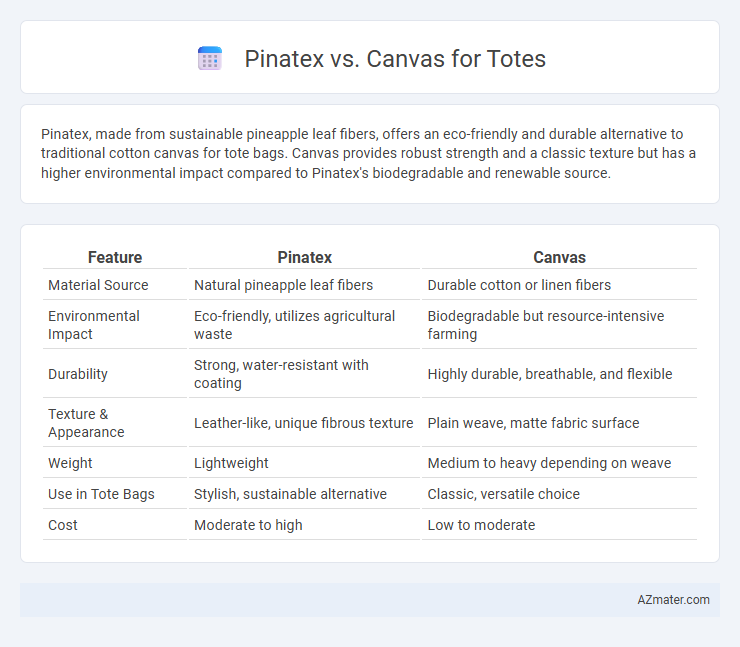Pinatex, made from sustainable pineapple leaf fibers, offers an eco-friendly and durable alternative to traditional cotton canvas for tote bags. Canvas provides robust strength and a classic texture but has a higher environmental impact compared to Pinatex's biodegradable and renewable source.
Table of Comparison
| Feature | Pinatex | Canvas |
|---|---|---|
| Material Source | Natural pineapple leaf fibers | Durable cotton or linen fibers |
| Environmental Impact | Eco-friendly, utilizes agricultural waste | Biodegradable but resource-intensive farming |
| Durability | Strong, water-resistant with coating | Highly durable, breathable, and flexible |
| Texture & Appearance | Leather-like, unique fibrous texture | Plain weave, matte fabric surface |
| Weight | Lightweight | Medium to heavy depending on weave |
| Use in Tote Bags | Stylish, sustainable alternative | Classic, versatile choice |
| Cost | Moderate to high | Low to moderate |
Introduction to Piñatex and Canvas
Pinatex, an innovative sustainable material made from pineapple leaf fibers, offers a lightweight, durable, and eco-friendly alternative to traditional fabrics ideal for tote bags. Canvas, a classic heavy-duty woven fabric typically made from cotton or linen, is renowned for its strength, durability, and ease of customization in tote construction. Both materials provide distinct benefits, with Pinatex emphasizing environmental sustainability and Canvas focusing on robust performance and versatility.
Material Composition and Origins
Pinatex is a sustainable alternative made from pineapple leaf fibers, a byproduct of the agricultural industry in the Philippines, offering an eco-friendly and biodegradable option. Canvas tote bags, traditionally manufactured from cotton, derive from natural cotton fibers predominantly grown in countries like the United States, India, and China, providing durability but with a higher environmental footprint due to intensive water and pesticide use in cotton farming. The choice between Pinatex and canvas depends on balancing sustainability, material origin, and environmental impact.
Environmental Impact Comparison
Pinatex, made from pineapple leaf fibers, offers a sustainable alternative to traditional canvas by utilizing agricultural waste, reducing landfill burden and water consumption significantly compared to conventional cotton canvas production. Canvas, primarily derived from cotton, demands extensive water, pesticides, and land resources, contributing to higher environmental strain and carbon emissions throughout its cultivation and manufacturing phases. Choosing Pinatex for totes supports a circular economy model by valorizing byproducts and lowering the ecological footprint associated with raw material extraction and processing.
Durability and Longevity
Pinatex, made from pineapple leaf fibers, offers strong tensile strength and natural water resistance, making it highly durable for tote bags. Canvas, typically crafted from cotton or linen, provides excellent wear resistance and can withstand frequent use but may require more care to maintain longevity. Both materials balance durability and longevity, with Pinatex offering sustainable toughness and Canvas delivering traditional robustness.
Aesthetic and Texture Differences
Pinatex offers a unique aesthetic with its natural, fibrous texture derived from pineapple leaves, giving tote bags an eco-friendly and artisanal appearance that stands out from traditional materials. Canvas provides a classic, sturdy texture with a smooth yet slightly coarse finish, ideal for versatile and durable tote designs. The organic, tactile feel of Pinatex contrasts with the utilitarian consistency of canvas, appealing to consumers seeking sustainable and visually distinctive accessories.
Weight and Comfort of Use
Pinatex tote bags offer a lightweight alternative to traditional canvas, weighing approximately 20-25% less, which enhances comfort during extended use. The natural pineapple leaf fibers in Pinatex provide a flexible yet durable texture, reducing shoulder strain compared to stiffer canvas materials. Canvas totes, while heavier and more rigid due to their cotton weave, offer superior breathability and cushioning, often preferred for carrying heavier loads.
Water Resistance and Maintenance
Pinatex offers superior water resistance compared to traditional canvas, as its natural pineapple leaf fibers are treated to repel moisture, making it ideal for tote bags exposed to wet conditions. Canvas tends to absorb water, requiring more frequent cleaning and drying to prevent mold and deterioration. Maintenance of Pinatex totes is generally easier, involving simple wiping with a damp cloth, while canvas bags often need specialized cleaning to maintain durability and appearance.
Ethical and Vegan Considerations
Pinatex, made from pineapple leaf fibers, offers a sustainable and cruelty-free alternative to traditional canvas, which is typically cotton-based and involves resource-intensive farming. Its production supports agricultural waste repurposing, reducing carbon footprint and water usage compared to canvas cultivation. Pinatex aligns with vegan values by eliminating animal-derived materials, making it a preferred choice for ethically conscious and environmentally aware consumers seeking stylish tote options.
Price and Accessibility
Pinatex offers an affordable alternative to traditional leather with prices typically ranging from $20 to $40 per yard, making it cost-effective for eco-conscious tote bag production. Canvas remains widely accessible and budget-friendly, usually priced between $10 and $30 per yard, favored for its durability and ease of sourcing worldwide. Both materials provide competitive price points, but Pinatex stands out for sustainability, while canvas excels in availability and established market presence.
Conclusion: Choosing the Right Tote Material
Pinatex offers an eco-friendly alternative to traditional canvas with its sustainable pineapple leaf fibers, making it ideal for environmentally conscious consumers seeking durability and unique texture. Canvas remains a versatile, cost-effective choice known for its strength and easy maintenance, suitable for everyday use and heavy loads. Selecting between Pinatex and canvas ultimately depends on prioritizing sustainability and aesthetics versus affordability and practicality for your tote bag needs.

Infographic: Piñatex vs Canvas for Tote
 azmater.com
azmater.com